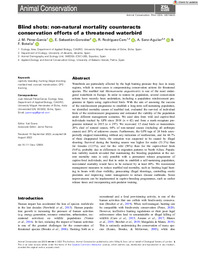Título :
Blind shots: non-natural mortality counteracts conservation efforts of a threatened waterbird |
Autor :
Pérez-García, Juan Manuel
Sebastián-González, Esther 
Rodríguez-Caro, Roberto 
Sanz-Aguilar, Ana
Botella Robles, Francisco  |
Editor :
Wiley |
Departamento:
Departamentos de la UMH::Biología Aplicada |
Fecha de publicación:
2023-08-04 |
URI :
https://hdl.handle.net/11000/31179 |
Resumen :
Waterbirds are particularly affected by the high hunting pressure they face in many
regions, which in some cases is compromising conservation actions for threatened
species. The marbled teal Marmaronetta angustirostris is one of the most endangered
waterbirds in Europe. In order to restore its population, several conservation
actions have recently been undertaken, including a population reinforcement programme
in Spain using captive-bred birds. With the aim of assessing the success
of the reinforcement programme to establish a long-term self-sustaining population,
we identified mortality causes of marbled teal, evaluated the survival of individual
birds of the reinforcement programme and estimated the viability of the population
under different management scenarios. We used data from wild and captive-bred
individuals tracked by GPS since 2018 (n = 42) and from a mark–recapture programme
initiated in 2015 (n = 297). We recovered 15 dead birds or transmitters:
20% died of natural causes, 60% of non-natural causes (including all anthropic
causes) and 20% of unknown causes. Furthermore, the GPS tags of 24 birds unexpectedly
stopped transmitting without any indication of malfunction, and for 66.7%
of these disappeared birds, the cessation was suspected to be caused by illegal
shooting. Survival during the hunting season was higher for males (31.3%) than
for females (12.5%), and for the wild (50%) than for the captive-bred birds
(9.4%), probably due to differences in migration patterns to North Africa. Population
viability models revealed that maintaining the breeding population at the current
mortality rates is only possible with a permanent release programme of
captive-bred individuals, and that in order to establish a self-sustaining population,
non-natural mortality would have to be reduced by at least 40%. We recommend
management measures to reduce marbled teal mortality, such as limiting legal hunting
to hours with clear visibility, prosecuting illegal shootings, controlling exotic
predators and improving water management to reduce disease outbreaks. Some
improvements can be implemented in captive-breeding programmes, such as earlier
release times and incorporating anti-predator training.
|
Palabras clave/Materias:
captivity breeding
hunting
illegal shooting
marbled teal
survival
translocation
GPS tracking |
Área de conocimiento :
CDU: Ciencias puras y naturales: Biología: Ecología general y biodiversidad |
Tipo de documento :
info:eu-repo/semantics/article |
Derechos de acceso:
info:eu-repo/semantics/openAccess
Attribution-NonCommercial-NoDerivatives 4.0 Internacional |
DOI :
https://doi.org/10.1111/acv.12906 |
Publicado en:
Animal Conservation (2023) |
Aparece en las colecciones:
Artículos - Biología Aplicada
|
 La licencia se describe como: Atribución-NonComercial-NoDerivada 4.0 Internacional.
La licencia se describe como: Atribución-NonComercial-NoDerivada 4.0 Internacional.
.png)
